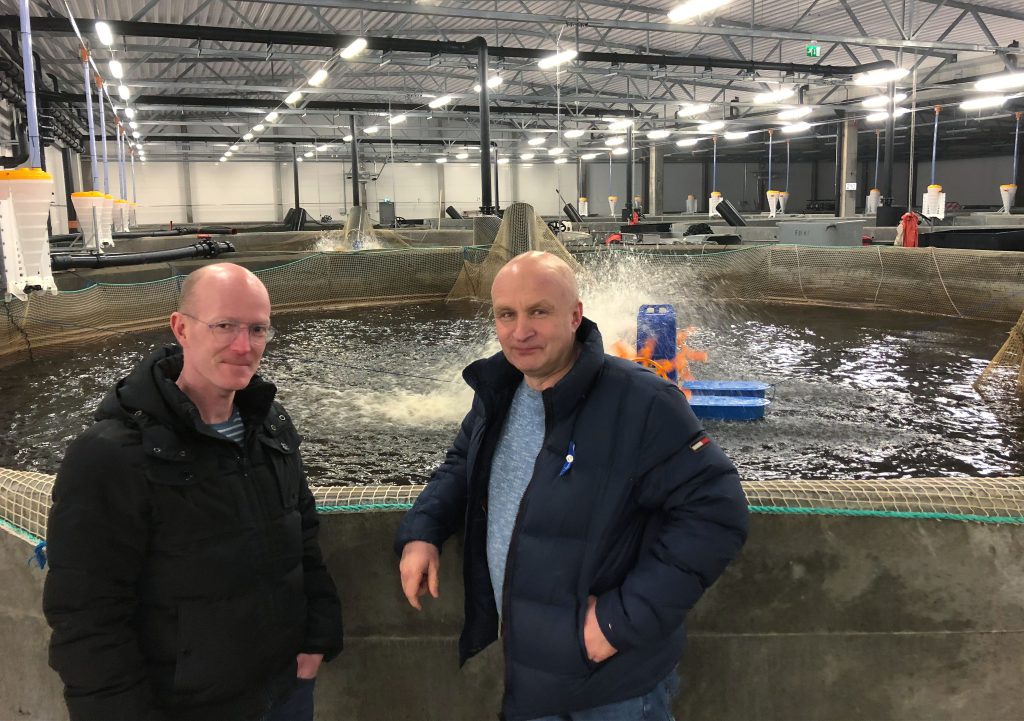Fish farming by closed indoor Recirculation Aquaculture Systems (RAS) has rapidly grown around the world. RAS technology offers several advantages over traditional aquaculture methods. Among others, it provides a more controlled system and has a potential to significantly reduce water pollution. Nonetheless, RAS sector still forms only a small fraction of the global fish farming. The potential of RAS farming has not yet been fully exploited.
Aquaculture industry must address various goals
Healthy and high-quality aquaculture production is an important part of the future food chain and food security. In order to grow and flourish, aquaculture industry must be able to address a wide range of economic and environmental policy goals. Although the carbon footprint of fish grown in traditional net pens has been demonstrated to be small, such farming often causes local eutrophication and pollution. Consequently, it is increasingly more difficult to obtain permits for the new facilities. Clearly, other ways to grow fish are needed to supplement the production.
Land-based Recirculating Aquaculture Systems (RAS) with integrated biological water recycling is widely considered a potential method for reducing pollution. Nutrients and other emissions are retained by the efficient filtering technology. Moreover, these systems can be almost completely closed from the surrounding environment which reduces the risk of many types of contaminations and other hazards.
Benefits of Recirculation Aquaculture Systems
RAS farming has many advantages over the traditional open net pens aquaculture. Nutrient load is low and the facility can be built on land, close to market. Growing fish in controlled conditions enables continuous harvest year-round. Besides, fish grow to commercial size faster than in traditional aquaculture facilities. Furthermore, fish cannot escape from closed systems and thereby there are little risk of genetic damage to wild fish stocks. RAS systems can be built wherever there is access to water and energy sources. A large RAS farm can eventually be built in the middle of a big city and logistical costs can thereby be markedly reduced. Even desert conditions present an insurmountable obstacle to the construction of RAS systems.
Clearly, recirculating aquaculture systems technology offers several advantages over traditional aquaculture methods. Notwithstanding, RAS facilities still produce only a small fraction of all farmed fish and the operation of a RAS-facility is often financially unprofitable. It is noteworthy, however, that RAS technology is developing quickly and more specialists have been brought into the field. Best economical results have been made with production of fish eggs to post-smolts but the range of RAS facilities has diversified. There are large RAS farms but also facilities based on smaller and more affordable technology. There is still a large difference in water recirculation percentage. In many cases around 80-90% of water is recirculated which means that the system constantly requires some new water. The development work towards 99-100% recirculation is ongoing and will likely be achieved in the near future.
Challenges in RAS systems
Major technical requirements are associated with the operation of land-based RAS systems. Energy and maintenance requirements are high, causing significant costs. Therefore, production capacity and fish density have to be high in order to make a RAS facility profitable. Use of sensors that collect extensive data on water quality and feed consumption, as well as wellbeing and growth of fish in real time, is highly beneficial and will become standard procedure in RAS farming. Clearly, there is major potential in the development of RAS systems, including automatic management systems of production.
The basis for the profitable operation is the full use of the facility’s capacity, minimization of production costs and high quality of the final product. Our consultants have been developing RAS facilities since 2012, and they are able to bring help both in the planning and implementation of the facilities.
The design of a RAS facility starts with the selection of fish species that will be used in the production. Furthermore, the species in question has to have a strain that is suitable for RAS breeding. Strains that are productive in traditional net pen farming may not be suitable for RAS-breeding. It is noteworthy that the range of species suitable for RAS systems is still relatively small but is likely to increase due to intensive research and development work in the field.
The diverse bacterial community in RAS-facility may produce chemical compounds that cause the taste of mud in the water. This can cause taste defects in farmed fish. The taste can be removed by keeping the fish for 1–2 weeks in water that is not recycled – this is called the freshening of the fish. It is noteworthy that the freshening depends largely on water temperature and the flow of water. Based on research by the Natural Resources Institute Finland (Luke), the use of oxidizing compounds speeds up the freshening of fish. Other aids have also been developed. Furthermore, while phosphorus is largely recovered in RAS facilities, reducing the nitrogen load is more challenging. Various solutions are now available to remove the nitrogen; up to 85% of the plant’s effluent nitrogen can be removed.
ISCG offers assistance
The demand for high-quality seafood is increasing worldwide, and the growing demand can only be satisfied with the help of aquaculture. International Seafood Consulting Group (ISCG) with its large network of experts offers its services to the renewing the aquaculture industry. There is a great potential for the establishment of next generation RAS facilities. Almost every stage of the recirculating aquaculture system process can be improved. Advanced technologies and automation can be employed to better monitor water flow and conditions, enabling more accurate control of key parameters for fish, thereby improving the quality assurance and economic performance.



